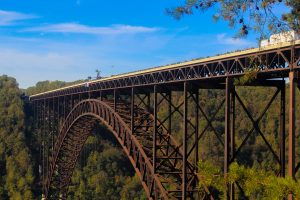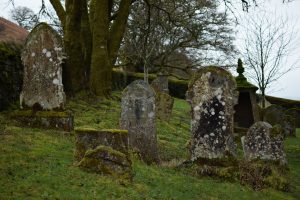First Settlers of Mill Creek- Elk Fork Area
Abraham Litton- A Historical Sketch- by John A. House,
published in the Jackson Herald, Ripley, WV, April 12, 1912 ( submitted by Daryl LYTTON )
It was an ideal Autumn day in October, 2 years ago, when I visited Abraham LITTON at his home near Gay. The night had been clear, cool, & sparkling, with the white glistening dew suggesting fog. But the cloudless day grew quite warm, with just the kind of Indian summer & the crisp fragrant air hanging over the purple distant hills. The glad singing water danced in the bright sunlight. Apples shown scarlet in the yellow leaves & roadside trees or woodland areas were catching the first tinge of flame or russet. A toilsome climb of 3/4 of a mile brought me on top of the divide near the Christian church & 400 yards above the level of Frozencamp Stream at the foot of the hill, & oh, what a grand, what a glorious view reached the eye!
A broad sweep of meadow & pasture land dotted here & there with white farm houses & patches of woodland with trees like minature outlines on the sky. As one looks out over miles & miles of worn ridges the higher hilltops rising like domes along their smoky summits, I can’t help but wonder if those living on hilltops realize all the beauties the land of nature spreads everyday so lavishly before their eyes.
About a half mile beyond, I turned south following the Fork Run Road to the entrance of the right hand fork up which my route lay. After a time the valley narrowed into a gulch with steep rocky sides & in one place the shear cliff of sandstone & over-footing of hunting parties in pioneer days. A few minutes climb through this picturesque gorge brought me out upon the upper level of the plateau, the plain lying 100 yards & above the level of the creek & roughly speaking a mile wide & a quarter long. With streams & bottom ridges & a peak all in minature was Turkeycamp Flats on Flatwoods of Elk.
Soon I came to the house of my friend, W.M. LITTON, surveyor, topographer & silversmith, who had just returned from a visit to Charleston or somewhere, & was now busy coaxing the inner mechanisms of some ones old watch which had gone on a strike. He at once volunteered his services to go with me to his father’s house & act as sort of a go-between being the old gentleman so hard of hearing he could not easily talk with strangers. So after a good rest, the pleasant chap, with a sumptous dinner prepared by Mrs. LITTON, herself a grand-daughter of one of Reedy’s early settlers, my friend & I walked over to his father’s house which was on a high point & near the mouth of Fork Run.
The house, a typical pioneer home of better class, was old & weather stained & stood on a gente slope in the midst of an orchard. Everything suggested peace & plenty in the sunset of life. One could not imagine the old time cider mill, the threshing floor, the flax break & room house of early days. Inside, we found the old patriatch, bowed by the weight of more than four score years yet alert & lively with excellent memory. One, like most folk, glad to talk of the olden times.
The very names of the streams perpetuated the story. Frozencamp tells of an awful night of horror & suffering–& Willy MALLONS, father-in-law of James RADER, lost his bearing & had to camp out on its waters. And Turkeycamp & Turkeyspring are from the RADER’s wild turkey hunts. And the name of Elk Fork comes from a pair of elks that Adam, the negro slave of Michael RADER, followed all day without getting a shot, so one account. But Mr. LITTON & others told me they had often seen the horns of the elk at the RADER house. the names Wolf Pen, Wolf Run, Grass Lick, Camp run & Panthers Knob, all speak of dog & rifle. Did space permit, I would tell some of the adventures met with hunters in this region.
When the tide of immigration gets from many localities to an El Dorado in some far off land where by chance of circumstances someone has gone, a neighbor of kinsman is sure to follow. Then another after that one & another until quite a company of old friends & nieghbors has built up in the new country. Thus it was in this case that the settlers on the upper James river in Botetourt & Rockbridge Counties, VA.
Just who was first in this movement would be difficult to ascertain. Posssibly it may have been Ruben REYNOLDS who settled on a packet near Walton about 1825. Perhaps Archiblad SKIDMORE who moved from ?Battlehorse to the George CASS farm below the mouth of tug Fork 1831 or 32. Then the stream thickened. In the year 1832, the son of Samuel RHODES purchased the FLETCHER farm on the west side of Mill Creek above Ripley. The same year William TALLEY came out & built the first house on the Jess CARNEY farm. And late that fall came David LITTON, who moved temporarily into one end of a double log cabin on Charles CARNEY’s ranch. About 1835, Sam RHODES, a brother of David LITTON’s wife, made the first improvement at the mouth of Billy’s Run, & John TALLEY moved to the ?COOUS place at the mouth of the creek where he remained for 2 years.
In 1836, George RHODES, David LITTON’s father-in-law with his sons Abe & Alec came to Billy’s Run locating at the John D. ?WHITTEN farm. And another son Ben RHODES at the ?APLIN place & another son Greg followed later about 1837 or 38. Old Josie TALLEY, Williams brother, located in the woods at ?JALBERTS on right fork of Elk, & Archie THOMAS, whose wife was Elizabeth RHODES, daughter of Samuel, at the mouth of Rough Run.
Afterwards, Abe LITTON, a brother of David, came to the left branch of Fork Run & the widow VANDYNE & family to the SKIDMORE farm. These, with perhaps pthers whose names I failed to get, formed quite a colony on the James River just as Buck ANDRES & Hacks CREEK each formed other colonies in the vincinity.
When David LITTON, Abraham’s father, first came to Mill Creek, there were but 5 families on Elk Fork. ____? at the mouth of the creek; the 3 RADER’s-Michael, James & Joseph; & a man named Andy WELSH who had a little mill above the mouth of Welsh Run–an eccentric who moved over on Tug Fork a few years later where he & his wife both died. There was a hut at the forks of Elk which had been built by that curious Indianized character, Double Bill PARSON, it was at that time unoccupied. The more immediate neighbors beyond were BONNET, HARPOLE, CARNS & SKIDMORE above Ripley. RAWLINS, CASCO & WESTFALL on Tug Fork. HIRE & WOLF on Lower Trace Fork. Captain Billy ?RIES & John PARSONS, John BORDEN, George KNAPP, near the present village of Frozencamp.
Some other early settlers on Elk were Steven & Andrew WESTFALL who moved over from Tug Fork. The latter married Mary sister of Jacob HIRE. He built the first cabin of this side of Gay 1834 but did not stay there long. I saw _ RAWLINS & a man named John after __ were living in a house all before 1845. About 1840 John /BORDEN built near Gay, he came from Ohio & had a title bond from WATSON for 200 acres of land on Turkeycamp Flats. Other settlers were John GREENLEAF on the side of Elk Fork Church, James WHITMAN, David HARPOLD & Michael WAITRIGHT.
Many many years ago in the early part of the 18h century, even before the formation of Frederick & Augusta Counties, there lived among the foothills a man named RHODES with his wife & 3 children, 2 boys 10 & 12, a girl was younger. There had been peace between Red Men & White for several years & the settlers had lost that caution commonly used in dealing with the Indians when their clearing had spread up the little valleys among the hills, far from the friendly shelter of the fork.
In this neighborhood this misplaced confidence had brought a shooting match which ended in sad tradegy. For the Indians, who were planning an uprising waited until the White men engaged had tried all their skill & when their rifles were empty, turned upon them & shot down, killed & scalped all their unsuspecting victims, & then rushing to the scene, killed or made prisoners of all the men, women & children.
RHODES was tomahawked & scalped in his doorway, & his wife & little girl carried into captivity. Later the women were also killed because they could not keep up with the savages in their flight across the mountains. But a chief took a fancy to the child on account of her red hair & adopted her. After peace was made she was returned to her friends.
The boys, whose names were John & Criss, were out watching the shooting match & when the slaughter began dodged unobserved into the underbrush where they stayed in hiding until the Indians had left the vincinity about sundown. They crept cautiously to the cabin where they found a loaf of bread which the elder boy tied in a tablecloth & swung over his shoulder when they started across the hills on the long tramp to a fort & safety. As they travelled through the night along a high ridge, the valleys below were lit up by the glare of burning buildings. Once they met a large bear which attracted by the bread, threatened an attack, but was kept off by the faithful hunting dog which accompianed them. This animal, with almost human audacity, neither barked nor made a noise, seemed to know the danger discovered by the savages. The boys succeeded in reaching the fort safely without further incident.
One of the boys, Christopher RHODES, grew to be widely famed as a hunter & marksman. He lived to be 115 years old & it is related that he won the prize of the Christmas shooting match when he was over 100. He’s sitting in his doorway, & steadying his long rifle against the door face he out shot the whole lot. The married man’s family lived in Rockbridge County. One son, Samuel, Mike’s father, was renowned as a hunter & Indian fighter. Once his house was burned & his stock all killed but the family escaped in safety to the fort.
The names of his 6 sons are given: Peter, Matthias, Michael & Benjamin. Christopher who married Catherine PETERS- Lexington, Virginia & Samuel who married Parthiena VANDYNE. The last 3 came to Mill Creek. Samuel removed to Middle Fork of ?Reedy 3 miles above the 3 Forks where he died years ago, the widow lived until 1844.
George RHODES was another son of Christopher & married either an ASHBY or PETERS & lived near the natural bridge, & he & 6 of his children settled on Elk Fork as has heretofore mentioned.
David LITTON was born in Berkeley Co. August, 1799. He married Peggy, daughter of George RHODES. When he first came to Mill Creek he first lived in one end of a double log cabin on Charles CARNEY’s farm while he & FOX, the other occupant, built on a lease they had taken of James RHODES on Spruce Run. He had compelted a cabin at the mouth of that stream when Steven WESTFALL who had the title bond from WATSON, took possession of his house. This man WATSON was said to have been an agent for a large boundary belonging to J.D. ROSSET, a Swiss, who was an extensive land owner in Mill Creek Valley. WESTFALL, however, helped LITTON build another cabin into which he moved in February 1883 before it had a door or window or chimney. FOX built the same winter where Elliott PRYOR now lives.
David LITTON’s children were Abraham, married Margaret WESTFALL, Alfred married Sarah GREENLEAF, Alexander married Lucinda RHODES, John D. married Martha FOWLEY, Cynthia married Llewellyn RHODES, Susannah married Noel WESTFALL, Emily married Henry (C THomas) of Arch Palms & settled in the vicinity.
Margaret LITTON was the daughter of Steven WESTFALL, who with his brother Jason & his sister the wife of George CASTO, first sheriff of Jackson County came from Hacker’s Creek. Father John WESTFALL was in the battle of Point Clement & had his hunting shirt shot full of holes but not seriously injured himself. These bullet holes he patched with red cloth & wore it with a little pride when he went to muster or in public places. Zachariah WESTFALL, John’s brother, with Thomas CARNEY & David CASTO are named as among the first pupils tending school at Buck Canyon settlement. Abraham LITTON’s 2nd wife was Miss Louisa HARNER, daughter of David HARNER of Coxes Fork. When Abraham came to Mill Creek he was almost 8 years old having been born November 8, 1824. He died on the 25th of last February, 3 months 17 days more than 87 years old, 79 of which was spent on Mill Creek & nearly all on one farm. When he came to Elk Fork the company had only been organized 2 years. John Quincy ADAMS was president of the United States & John BOYD governor of VA. All travel & conveyance of merchandise was by the pack horse trail. The nearest post office & grocery store was in Ripley, 12 to 15 miles away, & salt was carried by pack trains from the canawa Sailings above Charleston. Ripley then had 12 dwelling houses & that year after Beauchamp opened the first store, 1833. Deer, wolves, wild cats & wild turkeys were very abundant in the forests. The bears were growing scarce & panthers had almost disappeared. Though the people were rustic & plain in their ways, they were honest 7 hospitable & enjoyed life as fully as those away in the hustling, hurrying, restless today, 1912….do you remember?



